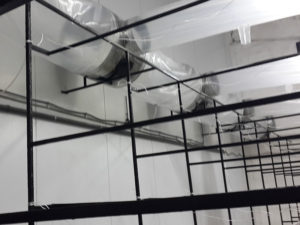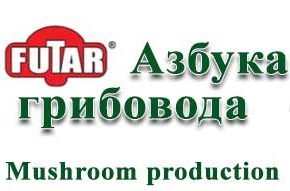Ventilation in the oyster mushroom cultivation chamber.
Ventilation in the oyster mushroom cultivation chamber.
The system consists of:
- a fan
- distribution duct,
- mixing chamber with shutters for fresh air and recirculated air
- cooling and heating radiators

Air distribution in the chamber is ensured by air ducts with nozzles, which enable air movement around the mushroom blocks at a speed of 0.2-0.5 m/sec.
Generalized calculation of air volume is 250-300 m3/h per one ton of substrate.
The speed of air flow from the nozzles should be no less than 8-10 m / sec at the top, immediately below the nozzle, and no less than 0.5-0.8 m/sec at the floor level.
In this case, the speed of air movement in the air ducts should be half the planned air speed at the nozzles. This is ensured by the calculated cross-section of the air ducts.
The optimal distance between the nozzles for uniform air distribution is – 0.5-0.8 m. In order to ensure such conditions it is necessary to choose the correct diameter of the nozzle outlet ranging from 0.03 m to 0.07 m.
The fan outlet is connected through the galvanized sheet adapter to the section of a central distribution box. The cross-section of the box is uniform along its entire length. By number of polyethylene hoses, nozzles are installed according to the diameter of polyethylene air ducts. The air volume in each duct is adjusted by reducing the nozzles cross-section.
All connections must be easily detachable, for cleaning and replacing polyethylene hoses.
Air conditioner scheme
The intake of fresh and recirculated air into the mixing chamber is carried out through the pipes of the same cross section. These valves are fitted with special shutters acting synchronously. The opening level of the fresh air shutter is equal to the closing level in the recirculation air damper.
Then the cooling coil is installed (if refrigerating equipment is used).
Further goes the heat exchanger, its parameters are designed to heat the air to the optimum operating temperature (22-24 ° C).
Instead of heat exchangers, it is possible to use air conditioners with cold/heat modes. The air conditioner should be located in the recirculated air intake area (wall mounted) or in the air distribution network (ducted setup).
Next is the supply fan, after which the air humidification system is installed.
Excessive pressure in the chamber is not acceptable! Mechanical exhaust ventilation is mandatory.
The fan exhausts air volume equal to that of fresh air, therefore, when designing the exhaust ventilation, it is necessary to ensure proper synchronization between the operation of the shutters of the exhaust fan and fresh air fan, or to adjust the speed of the exhaust fan motor through automatic control.
Air filtration:
Filters for rough and fine air purification are installed on the intake nozzles for fresh and recirculated air. Filters should have such a pore size that it is possible to catch spores of 2-3 microns in size, and efficiency of at least 95%. Usually one filter is used for many incubation cycles. The duration of filter operation increases with the use of pre-filters for rough air purification. The complexity of using filters lies in their high sensitivity to humidity. The filter change must be carried out when the air flow resistance has reached the value specified by the manufacturer.
Humidification:
- Steam humidification is considered to be the most effective at any outside air parameters (except for dry hot air in summer). This procedure requires special equipment: a steam generator or steam boiler, a special water treatment station, water and steam supply lines.
- Moistening by water irrigation is carried out by placing an aerosol generator or fine dispersion nozzles in an air duct just after the fan. The effectiveness of this humidification method in summer is enhanced by naturally warm air. Some of the heat energy is used to evaporate the sprayed water, some to cool the air.
When using irrigation system in winter, the air supplied to the heat exchanger must be heated to a temperature of at least 40-45°C, or the sprayed water must have a similar temperature.
There are various options for obtaining finely dispersed sprays:
- high pressure pumps (120-160 ATM);
- fog-projection devices;
- centrifugal plates of special purpose.
Air cooling
Air heat exchange units are considered the most effective elements for air cooling. The cooling agent is ice-cold water (+2-6°C), cold water (+10-12°C) or a mixture of ice water and polypropylene solutions, that ensure the constant temperature of the carrier below +4°C, significantly increasing the efficiency of air cooling.
The use of refrigerant (halocarbon, ammonia, etc.) as an energy carrier is very effective when using specialized equipment from various manufacturers.
In providing data for air cooling calculations, it is necessary to take into account the coefficient of heat exchange of substrate blocks, which amounts to 1.0-1.5 kW per ton of substrate, within permissible limits of block heating (30-32°C), adjustable temperature regime, thermal resistance coefficient of walls, ceilings and floor.
Air dehumidification
The most effective is the condensation method, which consists in passing humid air through the heat exchanger with the radiator fin temperature below the dew point. By controlling the water temperature in the heat exchanger (or radiator fin temperature), the volume of condensate from the air can be controlled.
